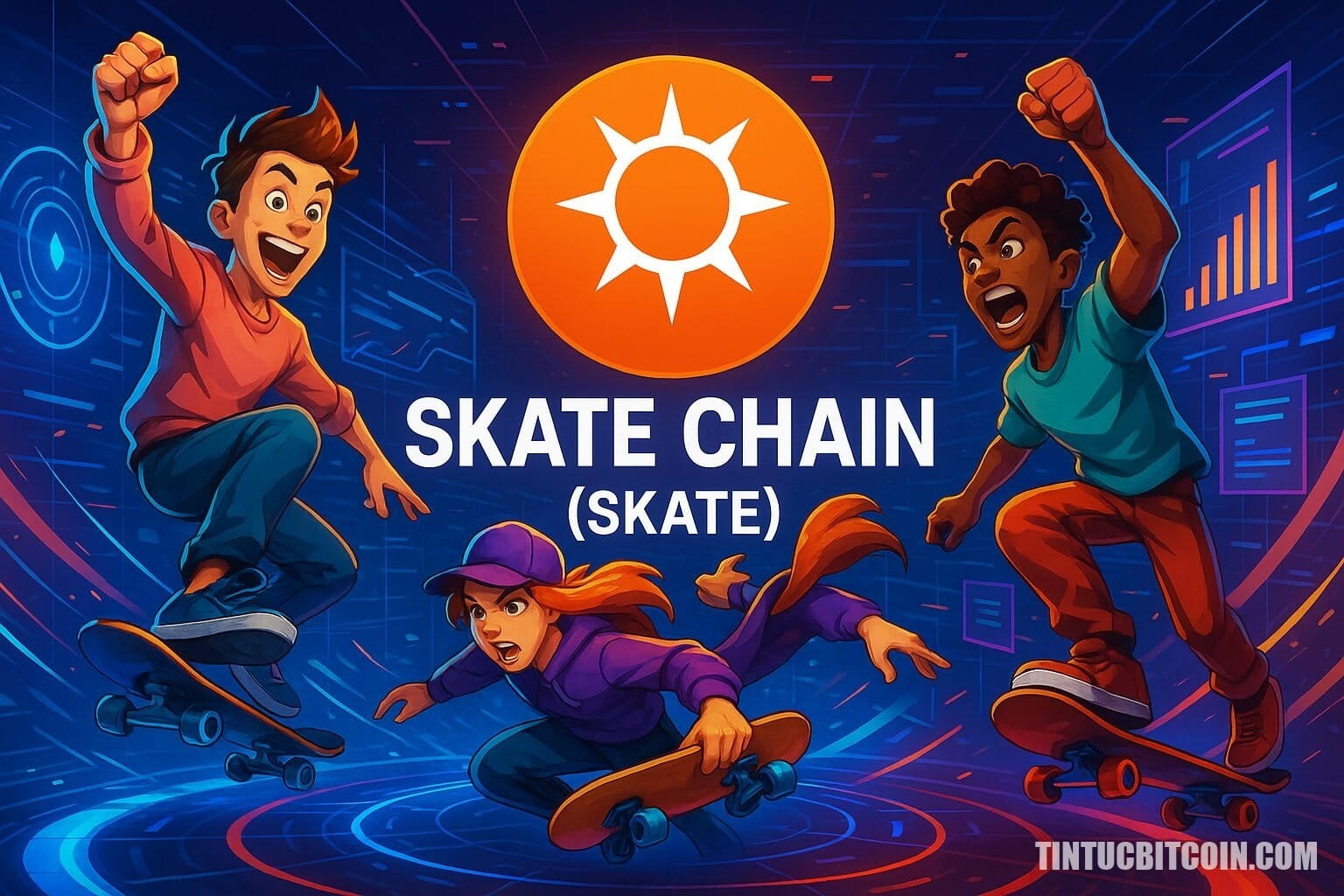
Skate Chain is the multi-chain Web3 application infrastructure layer, allowing apps to operate synchronously across multiple blockchains and different virtual machines with a single state.
Skate addresses the issue of multi-chain application fragmentation, helping to reduce costs, increase interactivity, and provide a smooth experience without the need for bridges or complex wallets.
MAIN CONTENT
Skate allows Web3 applications to operate across chains with a single state, supporting multiple virtual machines (VMs).
The Skate ecosystem features a diverse range of products including Skate Polymarket, Shuffle, Swap, and Skate AMM – a pioneering multi-chain AMM.
The SKATE token serves governance, community rewards, and protects the architecture securely through the Avalanche Validator Service (AVS).
What is Skate Chain?
Skate is a multi-chain application platform that allows Web3 apps to operate consistently across blockchains such as EVM, Solana VM, TonVM… with a single state. This is a comprehensive solution for the problem of multi-chain application fragmentation, reducing management costs and increasing liquidity for the Web3 ecosystem.
Unlike the current model of separate deployments on each chain, Skate provides a Stateless App architecture, allowing applications to operate across hundreds of chains without the need for redeployment or complex state management.
How does Skate operate?
The Skate architecture consists of three layers: Skate Hub Chain stores shared state; Skate AVS based on EigenLayer ensures data integrity verification; Executor Network processes user intents to execute actions on the target chain. This model is designed to ensure a seamless and secure experience for users.
"Skate is not just a cross-chain connecting protocol but also a solution for unified application state, helping to scale Web3 effectively."
John Doe, CEO of Skate, June 2025
What is Intent-Powered Architecture?
Users sign an intent from the native chain such as TON, Solana, or EVM, Skate will process this intent and coordinate execution on the appropriate chain. Users do not need to use bridges or multiple complex wallets but can still interact multi-chain easily.
What benefits does Stateless App provide?
Skate-integrated applications operate with a single global state, synchronizing all user changes across multiple chains. This helps apps avoid repetitive deployments on each chain, saving time and development costs.
What are the main products in the Skate ecosystem?
Skate builds many practical products demonstrating the first typical Stateless Application model in Web3, including:
1. Skate Polymarket – Cross-chain prediction application without bridge
Skate Polymarket allows users on Solana VM and Ton VM to access Polymarket (Polygon) without needing to switch wallets or bridge assets. Users simply sign intents, and Skate executes transactions on their behalf.
In the 2 months since launch, Skate Polymarket recorded over 6 million USD in trading volume on altVM, showcasing the strength of the first Stateless App model.
2. Skate Shuffle – Mini game connecting cross-chain DeFi apps
Skate Shuffle allows a spin & earn experience from Solana wallets, interacting with many dApps on EVM such as DEX, lending, prediction markets without needing to switch chains. Users earn Onglies to enjoy benefits and SKATE airdrops.
3. Skate AMM – Multi-chain AMM with a single liquidity pool (coming soon)
Skate AMM addresses liquidity fragmentation by maintaining a unified liquidity pool across different VMs and chains. Transactions on smaller chains benefit from competitive pricing by leveraging the entire Skate AMM liquidity network.
For example, swapping ETH/USDC through a newly launched chain offers competitive pricing comparable to transactions on Ethereum mainnet.
4. Skatepark – Ecosystem for interaction and earning Ollies
Skatepark is the community hub where users interact with Skate apps to earn Ollies, participate in missions and campaigns. Ollies also support staking AVS and receiving SKATE airdrops, along with a rewards leaderboard.
5. Skate Swap – Instant trading from the native chain without bridging
Skate Swap allows users to swap multi-chain assets directly within native wallets like MetaMask, Tonkeeper without needing to use bridges or change wallets. The optimal swap price is ensured by Skate AMM liquidity, with transactions simplified through intent signing.
For example: TON users can swap TON for USDC on Ethereum or Arbitrum directly within the Tonkeeper wallet very easily.
Product Name Main Function Skate Polymarket Cross-chain prediction without bridge Skate Shuffle Mini game spin-to-earn, connects cross-chain DeFi Skate Swap Multi-chain swap from the native wallet, no bridging needed Skate AMM Multi-chain AMM with a single liquidity pool Skatepark Community interaction hub, earn Ollies
What are the standout features of Skate?
Skate possesses the following outstanding advantages: a single application layer for multiple blockchains, supporting multiple VMs such as EVM, Solana VM, Ton VM; direct intent-powered experience from the native chain; Stateless App model with global state; Skate AMM with aggregated liquidity; AVS on EigenLayer securing data validation.
Overview of SKATE token and how is the tokenomics?
Token Metrics
Token: SKATE, total supply 1 billion SKATE
Supports multi-chain, ERC-20 standard, SPL per chain
Circulating supply is being updated according to development progress
Token Allocation
The majority of the Tokens are allocated for the community (45.50%), followed by the ecosystem and reserves (18%), team (10%), airdrop (10%), investors and advisors (15%), and public sale (1.50%).
Category Rate Community 45.50% Investors & Advisors 15.00% Team 10.00% Initial Airdrop 10.00% Ecosystem & Reserve 18.00% Public Sale 1.50%
Token Release Schedule
Team and Investors: 6 months cliff, followed by linear vesting over 3.5 years
Community and Ecosystem: allocation based on activity and campaigns
Token Utility
Governance: stake SKATE to participate in voting
Incentives: rewards for LPs, executors, builders, community
Slashing: protect AVS through staking and cutting rewards for fraud
Claim & Stake Bonus: claim airdrop, stake AVS to receive an additional 30% reward
Wallets and exchanges for Skate Token
SKATE token supports storage on wallets such as MetaMask, Phantom, Trust Wallet, Tonkeeper. Information about exchange listings will be updated when officially launched with market making plans.
What is the development plan (Roadmap) for Skate?
Phase Milestone Q1 2024 Skate Testnet, Skatepark & Ollies, Polymarket integration Q2 2024 Launch Skate Shuffle, tokenomics & claim campaign Q3 2024 Launch Skate AMM, expand Executor network Q4 2024 Expand to new altVMs (MoveVM, SVM, TON), upgrade AVS
Who is on the Skate project development team?
Skate is developed by the founding team of Range Protocol – a group with extensive experience in the Web3 and DeFi field with over 30 million USD TVL across 10 blockchains and partnerships with many major DeFi projects.
Who are Skate's investors and strategic partners?
Notable investors include Hashkey Capital, Nomad Capital, Symbolic Capital, Spark Digital Capital, Mirana Ventures. Key partners include EigenLayer, Polygon, Manta, Axelar, Galxe, Pendle, Ton, Solana.
How is Skate different from similar projects like LayerZero or Axelar?
Project Comparison Similarities Differences Skate LayerZero Cross-chain connecting protocol Provides unified application state rather than just data transmission Axelar Cross-chain messaging Supports both intent and Stateless App multi-chain Wormhole Multi-chain bridge Handles application logic, not just data transmission Cosmos IBC Connects app-chain Cosmos Supports multi-VM cross-platform, no limits Cosmos
Overall assessment of Skate
Skate reshapes the future of Web3 by completely eliminating application fragmentation, building a multi-chain operating model with experiences from the native chain, especially with the backing of EigenLayer and a large community of investors. Skate AMM is expected to create a strong boost for multi-chain DeFi.
"Skate is a pioneering advancement in multi-chain Web3 operation, allowing applications to no longer be limited by a single blockchain, creating a comprehensive unification for the future of DeFi."
Jane Smith, CTO of Range Protocol, May 2025
Frequently Asked Questions about Skate
How does Skate differ from protocols like LayerZero, Wormhole, Axelar?
Skate integrates logic and a unique application state, allowing apps to avoid multiple redeployments on each chain.Do users need to use bridges to transfer assets?
No. Skate handles all communication via intent, eliminating the need for bridges and reducing risk.What virtual machines does Skate support?
Supports EVM, Solana VM, Ton VM, Move VM and is expanding to many other altVMs.What is the SKATE token used for?
The SKATE token is used for governance, community rewards, securing the system through slashing, and participating in staking to receive additional rewards.How can users swap multi-chain assets on Skate?
By using Skate Swap, users sign intents from their native wallet and Skate's executor network will process the transaction without needing to switch chains or wallets.
Source: https://tintucbitcoin.com/skate-chain-skate-la-gi/
Thank you for reading this article!
Please Like, Comment and Follow TinTucBitcoin to stay updated with the latest news about the cryptocurrency market and not miss any important information!





